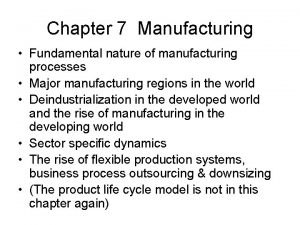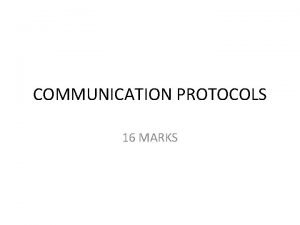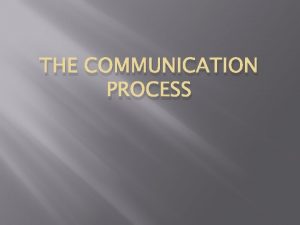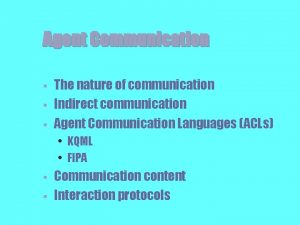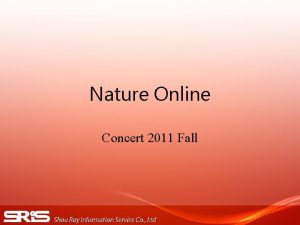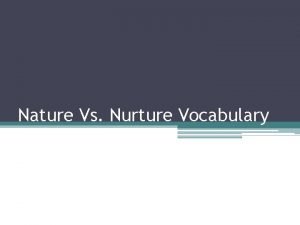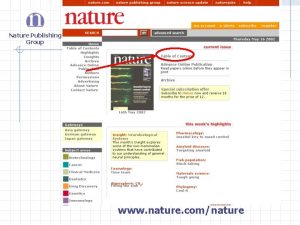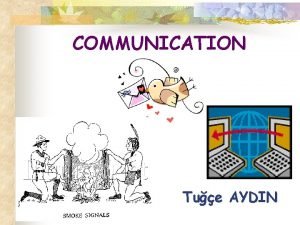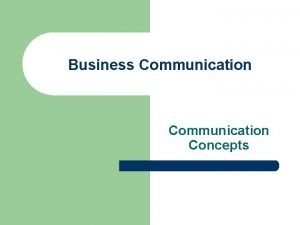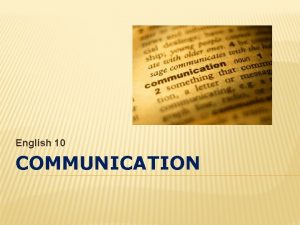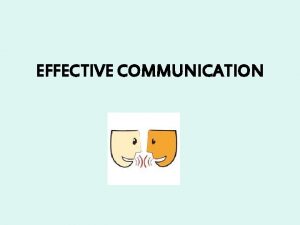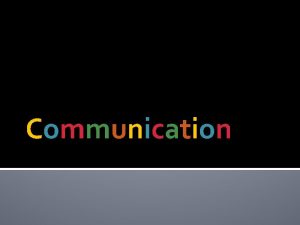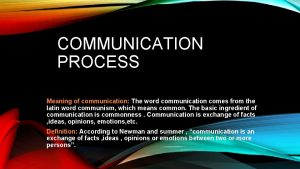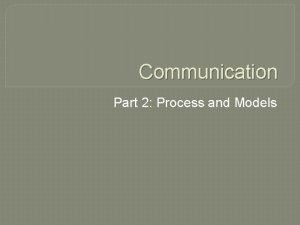NOTES The Nature of the Communication Process The





























- Slides: 29

NOTES The Nature of the Communication Process

The 3 Elements of Communication: 1. Process 2. Meaning 3. Symbols

Element #1: Process • This is the physical action and energy needed to communicate as well as the sequence of actions and the results of the actions

Element #2: Meaning • The thoughts, ideas, and understandings that go along with what is being communicated

Element #3: Symbols • The words (oral, written, or signed) and the non-verbal behaviors (facial expressions, gestures, voice tone, etc. ) that go along with what is being communicated.

5 Principles of Communication (5 things we know that communication is) 1. Transactional 2. Complex 3. Unavoidable 4. Continuous 5. Learned

1. What makes communication TRANSACTIONAL? • It involves an exchange of messages A TRANSACTION is an exchange of one thing for another. Example: giving money to a store for groceries. Or in this case, giving a message and getting feedback in return

2. What makes communication COMPLEX? • It is interactive, symbolic, personal, cultural, irreversible, impossible to duplicate, circular, and purposeful

3. Why is communication UNAVOIDABLE? • It is impossible not to communicate…you communicate when you are alone and when you are asleep. • Even a refusal to communicate is communication!!

4. Why is communication CONTINUOUS? • It goes on and influences every part of our lives

5. Why is communication LEARNED? • It is mostly made up of behaviors that come from the environment and experiences

10 Components (parts) of the Communication Process • • • Context Physical Environment Climate Sender Receiver • • • Message Channel Feedback Noise Barrier

1. What 3 things does context include? • People • Occasion • Task What is it’s function? • It lets you know what is going on in a situation: who is there, why, and what is happening What is an example? Students in speech class writing ideas for “Quick Speaks” Friends, during a vacation to the beach, playing sand volleyball

2. • Definition: the physical space in which communication takes place • Function: Influences the quality of communication • Types: Positive or negative • Examples: inside, outside, cold, hot, room, bus, cubicle, comfortable, uncomfortable, etc *A positive environment is safe, clean, comfortable, and well lit

3. • Definition: the emotional atmosphere in which communication takes place • Function: Influences the emotions, attitudes, and intellectual tone • Types: Positive or negative • Examples: stress, tension, boredom (negative) calmness, laughter, happiness (positive)

4. • Definition: The communicator who takes in data from stimuli, encodes and sends the message • Function: To send the message • Types: None • Example: Someone calling a friend about homework

5. • Definition: The communicator who acquires the message, decodes it, interprets it and reacts • Function: To get the message and give feedback • Types: None • Example: The person who gets a phone call from a friend about homework

6. • Definition: Information exchanged between communicators • Function: Conveys the meaning, feeling, and energy of the communication • Types: Intentional, unintentional; – verbal, vocal, non-verbal • Examples: Stating facts, asking questions, expressing feelings

7. • Definition: One person’s observable response to another person’s message • Function: Provides assurance, opportunities for adjustment, and insight into our own communication ability • Types: Oral, written, non-verbal (pos, neg. , neut. ) • Examples: nod, smile, head shake, words, gestures

8. • Definition: The way chosen to convey(deliver) the message • Function: Provides space and method to send a message • Types: Face-to-face, email, letter, phone call, etc. • Example: Writing a note to a friend

9. • Definition: Anything that interferes with communication and is usually temporary • Function: Interferes with and distracts communication • Types: Internal and external • Examples: (internal) hunger, worry, love, anxiety, illness (external) bells, voices, music, shiny things, movement, as well as odd, unusual clothing and hairstyles that are inappropriate for the context

10. • Definition: Anything that completely blocks communication…usually long term and very hard to eliminate • Function: blocks communication • Types: Internal and External • Examples: (internal) ignorance, jealousy, prejudice, obsessiveness, compulsiveness, over-competitiveness, defensiveness, educational level, financial situation, upbringing, culture, stubborn-hard headedness, oppositional-defiance (external) language differences, hearing problems, unclear speech, physical distance, permanent physical objects


Process Used By the Sender • Getting stimulus from Sensory Perception • Encoding the Message • Choosing a channel • Transmitting the Message

Process Used By The Receiver • Acquiring the message • Decoding the message • Interpreting the message • Reacting (providing feedback)

• Senders ENCODE • Receivers DECODE


People Occasion Task Climate External Barrier channel Internal Barrier External Barrier Sender Internal Barrier channel Receiver

Title: The Class Project Dilemma CONTEXT: Phil and Mary Louise (people) are in the library (occasion) working on a project (task) Physical Environment: Library; Cold; Lots of Light Internal Noise: Mary Louise is impatient with Phil’s behavior and worried about their grade Internal Noise: Phil is hungry , tired, and nervous that Mary Louise might find out his problem Climate: Tense and uncomfortable because they are not communicating well and do not like each other Message: So which part of the project do you want to do? External/Internal Barrier: Phil cannot read or write well and he is too embarrassed to admit it so he acts like he doesn’t care External Noise: The band is practicing right outside the window where they are sitting Internal Barrier: Mary Louise is prejudiced against guys “like Phil” that act like slackers Channel: Face-to-Face Receiver: Phil Sender: Mary Louise Feedback: The part where I sleep and you do all the work! Channel: Face-to-Face External Noise: There are lots of people walking around and distracting Phil
 Nature and nature's law lay hid in night
Nature and nature's law lay hid in night Nature nature controversy
Nature nature controversy Nature of science notes
Nature of science notes Ib biology nature of science notes
Ib biology nature of science notes Facteur g
Facteur g Types of media audience with examples
Types of media audience with examples Write about nature
Write about nature Intercultural communication notes
Intercultural communication notes Fundamental manufacturing processes
Fundamental manufacturing processes Software process model class 12 notes
Software process model class 12 notes Process design notes
Process design notes Writing process notes
Writing process notes Solvay process notes
Solvay process notes Serial parallel communication
Serial parallel communication What is oral communication and written communication
What is oral communication and written communication Parallel serial communication
Parallel serial communication Mass communication
Mass communication Oral communication conclusion
Oral communication conclusion Serial communication vs parallel communication
Serial communication vs parallel communication Hát kết hợp bộ gõ cơ thể
Hát kết hợp bộ gõ cơ thể Lp html
Lp html Bổ thể
Bổ thể Tỉ lệ cơ thể trẻ em
Tỉ lệ cơ thể trẻ em Voi kéo gỗ như thế nào
Voi kéo gỗ như thế nào Chụp phim tư thế worms-breton
Chụp phim tư thế worms-breton Bài hát chúa yêu trần thế alleluia
Bài hát chúa yêu trần thế alleluia Môn thể thao bắt đầu bằng từ chạy
Môn thể thao bắt đầu bằng từ chạy Thế nào là hệ số cao nhất
Thế nào là hệ số cao nhất Các châu lục và đại dương trên thế giới
Các châu lục và đại dương trên thế giới Công của trọng lực
Công của trọng lực








